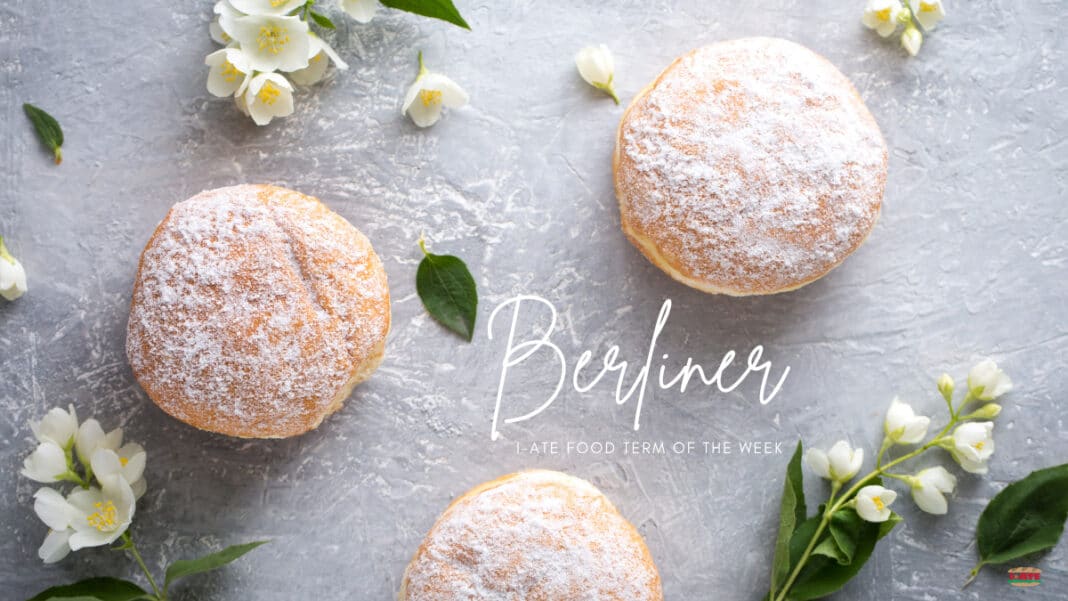What connects the Gutenberg press, John F Kennedy and German Karneval? The German pastry called Berliner! You can buy them all year, but the high season is New Year and Carnival. Interestingly, the filled doughnuts spread throughout Europe. The pastries do vary, but essentially, they are all made of sweet, deep-fried dough.
In Berlin itself, the sweet is known as Berliner Pfannkuchen (pancake) whereas in the South of German people call it Krapfen. However, in most regions in Germany the jelly-filled doughnut is called Berliner. John F. Kennedy’s famous declaration at the Berlin Wall, “Ich bin ein Berliner,” can be also translated as “I am a jelly doughnut.”
During the fifth season, you will find various types of them filled with jam, vanilla cream, Champagne cream, chocolate or eggnog. It is a common joke in Germany to fill one Berliner with mustard to trick unsuspecting guests.
The history of the sugary doughnut without a hole
Until the 16th century, sugar was very expensive. It became more affordable and fruit preserves gained in popularity when Caribbean sugar was imported. Before that, the doughnuts were filled with meat, fish, cheese, mushrooms and other savoury ingredients.
In 1485, a German cookbook was published in the town of Nürnberg, Germany. This book is special for two reasons. Firstly, it was one of the first printed cookery books using the famous Gutenberg press. Secondly, the book contained the recipe for the jelly-filled doughnut called gefüllte Krapfen. We don’t know if the author of the cook book actually invented it or if it is merely a record of an existing recipe. According to the legend, a baker from Berlin “baked” the doughnuts the old-fashioned way: deep-fried in lard without an oven and then filled with jam such as raspberry, cherry or strawberry. Immigrants from Central Europe settled in the US during the 19th-century and introduced their doughnuts.
Verwuerelter: the traditional Luxembourgish doughnut
Verwuerelter are traditional Luxembourgish doughnuts made of a combination of flour, butter, yeast, warm milk, sugar, eggs, and salt. The dough mixture is shaped into knots and then deep-fried until golden brown. Light and fluffy, these doughnuts are typically dusted with powdered or granulated sugar, and they can be enjoyed warm or chilled. These pastries are traditionally eaten and prepared for Fuesecht, the Luxembourgish equivalent of the German Karneval.
What is in a name?
The terminology varies in Germany. In the South of Germany (Bavaria, the home of the Octoberfest), they are named Krapfen. This term is also used in Austria, derives from Old High German kraffo, and is related to krappa in the Gothic language. In parts of North Italy, South Tyrol and Trivento the food is named kraffen or krapfen. Here are a few more variants that can be found in other countries:
- Slovenia – krof
- Portugal – Bola de Berlim (Berlin ball)
- Croatia – krafni
- Bosnia and Serbia – krofne
- Poland – paczki
- Ukraine – pampushky
- Czech Republic – kobliha
- Hungary – becsi fank
- Netherlands – Berlinerbol
- Belgium – boule de Berlin, Berlijnse bol
- Norway – berlinerbolle
- Finland – berliininmunkki
References:
Wikizero. 2021. Berliner. [ONLINE] Available at: https://www.wikizero.com/en/Berliner_(doughnut). [Accessed 19 February 2021].
German world. 2021. Doughnuts. [ONLINE] Available at: https://german-world.com/doughnuts-an-old-german-creation/. [Accessed 19 February 2021].
Thrillist. 2021. International types of donuts. [ONLINE] Available at: https://www.thrillist.com/eat/nation/international-types-of-donuts-you-need-to-try. [Accessed 19 February 2021].

Written by Victoria Milhan, Schuman Communication Trainee Terminology Coordination Unit. She holds master’s degrees in English Language (linguistics) and Medieval English Literature, Newer English Literature and Celtic Studies. Victoria is enrolled as a PhD student at Bonn University in Germany.

